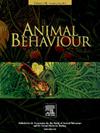Energy expenditure of Adélie penguins during the breeding season: females pay the cost in years of low food availability
IF 2.3
2区 生物学
Q2 BEHAVIORAL SCIENCES
引用次数: 0
Abstract
Changes in prey availability can lead to mismatches between consumers and resources, decreasing the fitness of consumers, especially during periods of high energy demand such as reproduction. We investigated interseasonal variation in the foraging behaviour of chick-rearing Adélie penguins, Pygoscelis adeliae, in a declining colony in the West Antarctic Peninsula to assess the impact of changes in prey abundance. Specifically, we analysed how these changes affect the energetic cost of males and females during the breeding season. Using information from foraging trips, diet, body condition and daily energy expenditure of 38 Adélie penguins breeding in Ardley Island, King George Island, in 2019/2020 and 2021/2022, we found that during low food availability conditions, penguins were forced to increase their foraging effort and their body mass was lower. Specifically, females extended their foraging trips, resulting in 40% higher energy expenditure compared to a year with high prey availability. We observed no significant changes in physiological condition, breeding success or trophic niche. The lower fat reserves and higher energy expenditure of females during the breeding season with low food availability may render them more vulnerable to the challenging conditions of the winter season, with potential negative consequences on population trends.
求助全文
约1分钟内获得全文
求助全文
来源期刊

Animal Behaviour
生物-动物学
CiteScore
4.60
自引率
8.00%
发文量
236
审稿时长
10.2 weeks
期刊介绍:
Growing interest in behavioural biology and the international reputation of Animal Behaviour prompted an expansion to monthly publication in 1989. Animal Behaviour continues to be the journal of choice for biologists, ethologists, psychologists, physiologists, and veterinarians with an interest in the subject.
 求助内容:
求助内容: 应助结果提醒方式:
应助结果提醒方式:


